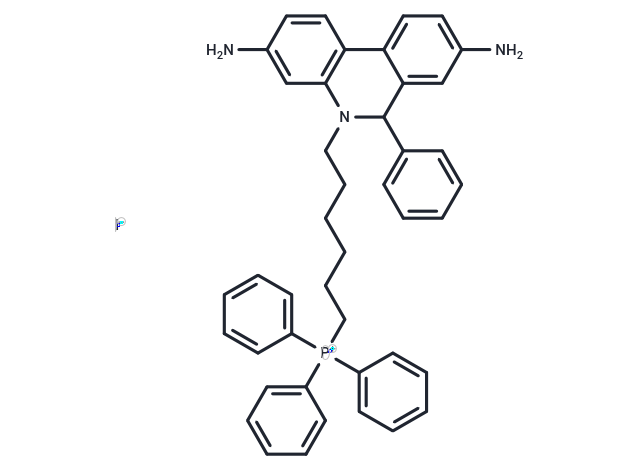 Your shopping cart is currently empty
Your shopping cart is currently empty

MitoSOX Red is a novel fluorescent probe that is specific and cell membrane-permeable and targets mitochondria in living cells.MitoSOX Red is oxidized by superoxide upon entry into the mitochondria and is not oxidized by other ROS or RNS-generating systems.MitoSOX Red then binds to nucleic acids in the mitochondrion and produces a strong red fluorescence.MitoSOX Red can be used as a fluorescent indicator for the specific detection of superoxide.MitoSOX Red can be used as a fluorescent indicator for the specific detection of superoxide. MitoSOX Red can be used as a fluorescent indicator to specifically detect superoxide. Superoxide dismutase (SOD) prevents the oxidation of MitoSOX Red.

| Pack Size | Price | USA Warehouse | Global Warehouse | Quantity |
|---|---|---|---|---|
| 50 μg | $48 | In Stock | In Stock | |
| 100 μg | $81 | In Stock | In Stock | |
| 500 μg | $278 | In Stock | In Stock | |
| 1 mg | $417 | In Stock | In Stock | |
| 5 mg | $948 | In Stock | In Stock | |
| 10 mg | $1,270 | In Stock | In Stock | |
| 25 mg | $1,880 | In Stock | In Stock | |
| 50 mg | $2,530 | In Stock | In Stock |
| Description | MitoSOX Red is a novel fluorescent probe that is specific and cell membrane-permeable and targets mitochondria in living cells.MitoSOX Red is oxidized by superoxide upon entry into the mitochondria and is not oxidized by other ROS or RNS-generating systems.MitoSOX Red then binds to nucleic acids in the mitochondrion and produces a strong red fluorescence.MitoSOX Red can be used as a fluorescent indicator for the specific detection of superoxide.MitoSOX Red can be used as a fluorescent indicator for the specific detection of superoxide. MitoSOX Red can be used as a fluorescent indicator to specifically detect superoxide. Superoxide dismutase (SOD) prevents the oxidation of MitoSOX Red. |
| Cell Research | I. Solution preparation
1. MitoSOX Red stock solution preparation: MitoSOX Red is dissolved in DMSO, usually at a concentration of 1-10mM, which can be optimized according to experimental conditions. 2. Working solution preparation: Dilute the MitoSOX Red stock solution to a concentration suitable for the experiment. Common final concentrations range from 1 to 10 µM, but should be optimized according to cell type and experimental conditions. 3. Control reagent: Use superoxide dismutase (SOD) as a negative control because SOD will scavenge superoxide and prevent oxidation of MitoSOX Red. II. Cell labeling 1. Cultivate cells: Inoculate cells into appropriate culture vessels (such as culture dishes or coverslips) and culture for 24-48 hours until cells are fully attached and growing. 2. MitoSOX Red staining: Add the working concentration of MitoSOX Red to the culture medium. Incubate at 37°C for 10 to 30 minutes. Staining time should be optimized based on cell type. 3. Washing: After incubation, wash cells thoroughly with PBS to remove excess MitoSOX Red. 4. Fluorescence detection: 1) Excitation and emission wavelengths: MitoSOX Red has an excitation wavelength of 510 nm and an emission wavelength of 580 nm. Use a fluorescence microscope or flow cytometer equipped with appropriate filters to detect red fluorescence. 2) Superoxide detection: The intensity of red fluorescence is proportional to the level of superoxide in mitochondria. Higher fluorescence intensity indicates higher superoxide levels, while lower fluorescence indicates lower superoxide levels. 5. Experimental controls: 1) Positive control: Use known oxidative stress inducers, such as Paraquat or Rotenone, to elevate superoxide levels in cells, thereby increasing the fluorescence of MitoSOX Red. 2) Negative control: Add Mito-TEMPO to prevent superoxide from oxidizing MitoSOX Red, thereby reducing or eliminating fluorescence. 6. Quantitative analysis: For quantitative analysis, flow cytometry can be used to measure the fluorescence intensity of individual cells, which helps to analyze superoxide levels in a large number of cells. Qualitative assessment can also be performed by image analysis. Notes: 1. MitoSOX Red is light-sensitive, so it should be avoided from exposure to light during storage and operation. 2. This probe specifically targets mitochondria and will only be oxidized by superoxide, not other ROS or RNS, thus ensuring the specificity of the detection. 3. During the incubation process, ensure that the cells are not overly stressed or damaged to avoid causing artifacts or nonspecific fluorescence. |
| Molecular Weight | 759.7 |
| Formula | C43H43IN3P |
| Cas No. | 1003197-00-9 |
| Smiles | [I-].NC=1C=CC=2C3=CC=C(N)C=C3C(C=4C=CC=CC4)N(C2C1)CCCCCC[P+](C=5C=CC=CC5)(C=6C=CC=CC6)C=7C=CC=CC7 |
| Color | Purple |
| Appearance | Solid |
| Storage | keep away from direct sunlight,store at low temperature,keep away from moisture | Powder: -20°C for 3 years | In solvent: -80°C for 1 year | Shipping with blue ice/Shipping at ambient temperature. | |||||||||||||||||||||||||||||||||||
| Solubility Information | DMSO: 101 mg/mL (132.95 mM), Sonication is recommended. | |||||||||||||||||||||||||||||||||||
| In Vivo Formulation | 10% DMSO+40% PEG300+5% Tween-80+45% Saline: 3.3 mg/mL (4.34 mM), Sonication is recommeded. Please add the solvents sequentially, clarifying the solution as much as possible before adding the next one. Dissolve by heating and/or sonication if necessary. Working solution is recommended to be prepared and used immediately. The formulation provided above is for reference purposes only. In vivo formulations may vary and should be modified based on specific experimental conditions. | |||||||||||||||||||||||||||||||||||
Solution Preparation Table | ||||||||||||||||||||||||||||||||||||
DMSO
| ||||||||||||||||||||||||||||||||||||
| Size | Quantity | Unit Price | Amount | Operation |
|---|

Copyright © 2015-2026 TargetMol Chemicals Inc. All Rights Reserved.